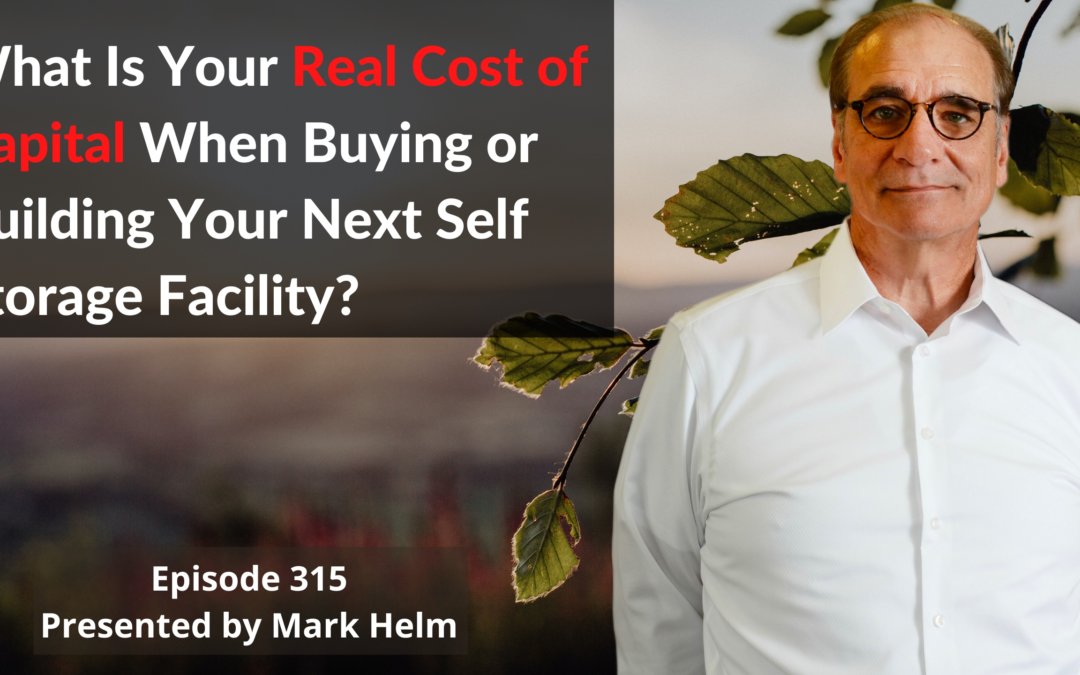My cost of capital is one of the metrics I use today when buying self storage.
I have said this before and don’t think any idea I have ever discussed has caused more head-scratching.
First of all, many don’t understand the concept and at the same time, wonder why it’s not that important.
Perhaps it is not that important, but is it one I use in considering a deal? It is not the most important one necessarily, but one I use.
Why?
Ultimately, because of its simplicity.
I am looking for a spread.
I am looking for the difference between the cost o9f the money I am putting in the deal and the return from the deal I am going to get.
Sample Example
Here is a simple example. Let’s say we are buying a triple net lease deal, like a Walgreens, spinning off $100,000 dollars.
In other words, after all the expenses (in this case, the tenant pays all of them), what you have left before a loan payment, or if you are paying all cash, what you have left is $100,000.
If you paid all cash and you expect to receive an 8% return on your money, you are saying you can pay an 8% CAP rate.
Said another way, your cost of capital in this pretend all cash deal is 8%.
You cannot buy any income-producing real estate like a Walgreens for anything near an 8% CAP today.
So, we usually use financing (cheap money) to close that gap.
Let’s look at some numbers.
Let’s say this deal is selling for a 5% CAP (good luck today finding anything like a Walgreens trading at a 5% CAP).
The cost of $100,000 NOI trading at a 5% CAP is $1,666,667. (100,000 divided by .05 = 1,666,667.
Let’s say I am putting 25% down and need an 8% cash-on-cash return for any cash I put in the deal.
Why 8%? Well, let’s say I feel I could put that money into an index mutual fund and average that amount over the next five to ten years. So, I want at least that return if I am going to do this deal.
You come up with your own “return of any cash” you put into a deal today. If you have investors, they will tell you what the minimum return they expect, usually in the form of a preferred return.
So, 25% of $1,666,667 is $416,667. 08% of $416,667 is $33,333 per year.
So, we will get the rest of this pretend deal or 75% of its cost from a bank at, let’s say, 4% interest. So, 75% of $1,666,667 is $1,250,000.
If we have a 20-year loan at 4% interest, our yearly debt service is $90,897.
So here are the numbers:
| Cost of Asset: | $1,666,667 |
| Equity: | $416,667 |
| Debt: | $1,250,000 |
| Cost of Equity (8%): | $33,333 |
| Cost of Debt (4%): | $90,897 |
| Total Cost of Capital: | $124,230 |
| Percent of Cost of Asset: | 7.5% |
So, in this fictitious deal, my cost of capital is 7.5%, and the deal is generating a 5% return.
Crazy. For the life of me, I can’t figure out why and how these Walgreens deals sell at a 4% or less CAP rate, but I guess it must meet someone’s needs.
It is slightly more complex to calculate with self storage, but the principle is still the same.
Let’s look at a deal we have done.
We purchased a 34,200 facility for $1,949,000. We added an additional 24,500 at a final; cost of $57.08 psf, or an additional $1,398,411 (a few cost overruns).
Total cost is $3,447,411.
I was paying a 12% preferred return then, and my loan was at 4.25% interest on a 25-year loan. The numbers looked like this.
| Cost of Asset: | $3,447,411 |
| Equity: | $950,234 |
| Debt: | $2,397,177 |
| Cots of Equity (12%): | $114,028 |
| Cost of Debt (4.25%): | $155,837 |
| Total Cost of Capital: | $269,865 |
| Percent of Cost of Asset: | 7.8% |
| Actual NOI When Established: | $322,569 |
| Percent of Cost of Asset: | 9.6% |
The longer one holds this, the further spread gets due to increased NOI (in most cases, self-storage).
Now, this is not the only metric I use. In our business strategy, we are looking closely at cash-on-cash returns for the equity invested and Internal Rates of return over the life of the deal.
But this fairly simple metric lets me know what this deal really will cost me for the money in the deal, and given what we expect the net operating cash flow to be, is there a positive or negative spread.
So, the final question is, how much of a spread are we looking for. Like most things in life, I don’t have a specific number.
I will say that I have noticed I tend to lean into deals that have a 2% to 3% positive spread.
But remember, this is just one metric I look at.
But its beauty is its simplicity.



